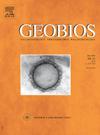Mississippian-Lower Pennsylvanian foraminifers from the Sierra Nacimiento and San Pedro Mountains, North-Central New Mexico, USA
IF 1.6
4区 地球科学
Q2 PALEONTOLOGY
引用次数: 0
Abstract
In the Sierra Nacimiento-San Pedro Mountains-Jemez Mountains of north-central New Mexico (USA), the thin succession of Mississippian sediments is termed the Arroyo Peñasco Formation, overlain by the Log Springs Formation. The Arroyo Peñasco Formation is subdivided into Del Padre Member composed of siliciclastic sediments and the overlying Espiritu Santo Member composed of carbonate sediments. Foraminifers of the Espiritu Santo Member at Lion Spring in the northern San Pedro Mountains indicate a Tournaisian age. The lower Tournaisian (= Hastarian = biozones MFZ1-4 of Poty et al., 2006 [Geological Magazine 143, 829–857]) is locally characterized by Septaglomospiranella ex gr. primaeva, Septabrunsiina minuta and Tournayella sp. The upper Tournaisian (= Ivorian = biozones MFZ5-9 of Poty et al., 2006) is characterized by Spinoendothyra, Inflatoendothyra and Tuberendothyra. In the Sierra Nacimiento-San Pedro Mountains-Jemez Mountains, the sediments of the Arroyo Peñasco Group are unconformably overlain by nonmarine redbeds of the Log Springs Formation (Serpukhovian/upper Chesterian). Some of the carbonate clasts of the basal conglomerate of the Log Springs Formation at Lion Spring contain late early Viséan (biozone MFZ11B of Poty et al., 2006) foraminifers and algae, including Koninckopora and Paraarchaediscus. These carbonate clasts are reworked from the underlying Arroyo Peñasco Formation (Espiritu Santo Member). In north-central New Mexico, a transgression during the Early Pennsylvanian (Morrowan) caused deposition of the shallow marine sediments of the Osha Canyon Formation. The Morrowan age of the Osha Canyon Formation is based on Nigrispiroides nov. gen., Iriclinella, Globivalvulina, and Millerella.
来自美国新墨西哥州中北部的Sierra Nacimiento和San Pedro山脉的密西西比-下宾夕法尼亚有孔虫
在美国新墨西哥州中北部的Sierra Nacimiento-San Pedro Mountains- jemez Mountains,密西西比沉积的薄层序列被称为Arroyo Peñasco组,其上覆盖着Log Springs组。Arroyo Peñasco组可分为Del Padre组和espiiritu Santo组,其上为碳酸盐沉积。圣佩德罗山脉北部狮子泉的埃斯皮里图圣成员的有孔虫表明了图尔纳时代。图尔奈世下部(= Hastarian = MFZ1-4, Poty et al, 2006)局部特征为Septaglomospiranella ex gr. primaeva、Septabrunsiina minuta和Tournayella sp.;图尔奈世上部(= Ivorian = MFZ5-9, Poty et al, 2006)局部特征为Spinoendothyra、Inflatoendothyra和Tuberendothyra。在Sierra Nacimiento-San Pedro Mountains- jemez Mountains, Arroyo Peñasco群的沉积物被Log Springs组(Serpukhovian/upper Chesterian)的非海相红层不整合覆盖。狮子泉Log Springs组基底砾岩的部分碳酸盐岩碎屑中含有晚、早vis (Poty et al., 2006的MFZ11B生物带)有孔虫和藻类,包括Koninckopora和Paraarchaediscus。这些碳酸盐碎屑来自下部的阿罗约Peñasco组(圣埃斯皮里图成员)。在新墨西哥州中北部,早宾夕法尼亚(Morrowan)时期的一次海侵导致了奥沙峡谷组浅海沉积物的沉积。Osha峡谷组的Morrowan时代是基于Nigrispiroides nov. gen.、Iriclinella、Globivalvulina和Millerella。
本文章由计算机程序翻译,如有差异,请以英文原文为准。
求助全文
约1分钟内获得全文
求助全文
来源期刊

Geobios
地学-古生物学
CiteScore
3.30
自引率
6.20%
发文量
28
审稿时长
6-12 weeks
期刊介绍:
Geobios publishes bimonthly in English original peer-reviewed articles of international interest in any area of paleontology, paleobiology, paleoecology, paleobiogeography, (bio)stratigraphy and biogeochemistry. All taxonomic groups are treated, including microfossils, invertebrates, plants, vertebrates and ichnofossils.
Geobios welcomes descriptive papers based on original material (e.g. large Systematic Paleontology works), as well as more analytically and/or methodologically oriented papers, provided they offer strong and significant biochronological/biostratigraphical, paleobiogeographical, paleobiological and/or phylogenetic new insights and perspectices. A high priority level is given to synchronic and/or diachronic studies based on multi- or inter-disciplinary approaches mixing various fields of Earth and Life Sciences. Works based on extant data are also considered, provided they offer significant insights into geological-time studies.
 求助内容:
求助内容: 应助结果提醒方式:
应助结果提醒方式:


